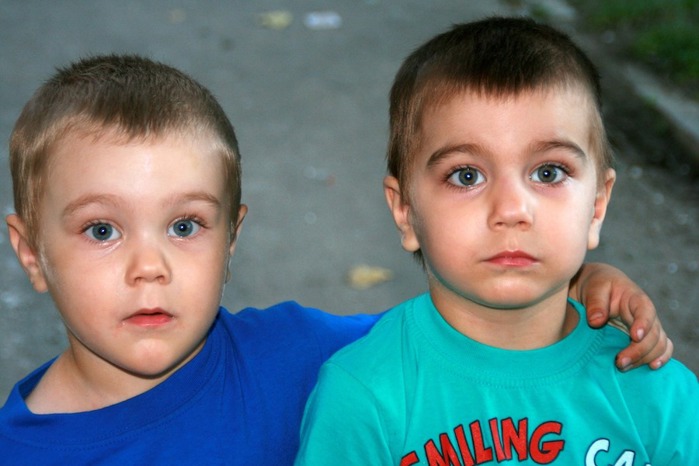
Could it be possible for conjoined twins to have different fathers?
September 23, 2015

- Related Topics:
- Chimera,
- Developmental biology,
- Relatedness
A high school student from China asks:
"I heard it is possible for two twins to have different fathers. If these two twins, each with a different father, conjoin together, would the conjoined baby have two fathers? Is this even possible? If so, how would the genetics work for the conjoined baby?"
First off, yes, it is possible for twins to have different fathers. This goes by the exciting name heteropaternal superfecundation. It is much more common in other animals, but it can and does happen in people too.1
And of course twins can be conjoined. But these twins are identical which means by definition they have the same mom and dad. In fact, they have the same DNA!
So no, conjoined twins with different fathers is not possible.

But something close to this just might be possible.
While twins of the nonidentical kind can’t become conjoined, they can become something called chimeras. This is where fraternal twins fuse together very early on in development.
The end result is not two separate, connected people but one person with a mix of both twins. Some of the chimera’s cells have the DNA of one twin and the rest have the DNA of the other.
Theoretically then we could have someone with chimerism who has two different dads. Basically the first step would be that two eggs get fertilized by different men’s sperm. Then these twins would fuse together to create a chimera with two different dads.
Since both steps are rare, it will be really rare for both to happen at the same time. But it is definitely possible. So for the rest of this article, I’ll focus on how that could happen.
Very Close Brothers or Sisters
Like I said, chimeras happen when fraternal twins fuse together to make one person. This usually isn’t a big deal except sometimes when it happens with a brother and a sister. Then there can be issues like having one testicle and one ovary, for example.2,3
Most people with chimerism have much more subtle signs like patches of different colored hair or skin. Each twin’s cells are expressing their own genetics and so the chimera has each twin’s skin tone, hair and eye color in the different patches where they are. (And most people with these pattern differences actually aren’t chimeras.) 4
And sometimes the differences are so subtle that there are essentially no outward signs of being a chimera. They don’t know they are a chimera until they get a weird blood type test result.5 Or sometimes, when they “fail” a paternity/maternity genetic test.6
This is because when someone with chimerism passes down his or her DNA, it is from one twin or the other. And if that twin’s DNA doesn’t happen to match the DNA of the cells getting tested which happen to have the other twin’s DNA…

Duncle or Mont
Imagine you go to a fertility clinic and your sperm and your wife’s eggs are combined and then the fertilized eggs are implanted into your wife. Nine months later she gives birth to a beautiful baby boy.
A routine blood test on the baby shows he is AB and a red flag goes up. There isn’t any easy way to explain how you and your wife produced the baby’s blood type since you are both A. You assume the clinic must have implanted the wrong embryos!
You do DNA testing and find that you aren’t his father. The DNA is not a good enough match.
But then you do one more test, an ancestry test that can see more distant relationships, and it shows that the two of you are definitely related. Instead of father/son, though, it shows uncle/nephew.
If you think about it, this is the result you might expect if dad was a chimera. Fraternal twins are as related as any brother, and your brother’s son is your nephew.
So imagine you are a chimera. Some of your cells have one DNA and the rest have a second set of DNA. The DNAs are related to each other as brothers.
Now the DNA that fertilized the egg is from one brother and the DNA from the tested cells (usually cheek cells) is from the other. When the DNA from the cheek cells is compared to the baby’s DNA, it will look like a brother is the dad.
In other words, it looks like the baby is the man’s nephew when he is really his son! He is the baby’s duncle (dad + uncle). (A mom would be a mont, mother + aunt.)
This isn’t all just made up either. It is very similar to what happened recently to a family who contacted me.
When they took a standard DNA test, they could not tell the baby and the dad were related. It really looked like the clinic had made a really big mistake.
But an ancestry DNA test was able to show their true relationship. In this case, the baby’s DNA was about 25% related to the dad’s cheek cells.
And they aren’t the only example of this. Lydia Fairchild is perhaps the best known, and you can read more about her story here.
Two different fathers?
Now let’s go back to the heart of your original question: could a chimera ever have two different fathers? It’s theoretically possible. But probably really unlikely.
As we just discussed, a chimera is a wonderful mix of two fraternal twins.
And it is possible for fraternal twins to have different fathers. It’s rare, but there are examples of this happening. For example, one study identified 3 examples of fraternal twins with different fathers, out of 127 cases that they looked at.1
It’s important to note though, that all of these cases were part of disputed paternity suits! That means you might expect this group to show a higher rate dual paternity, compared to your average set of fraternal twins. That same study put a lower estimate out as well: 1 per 13,000 sets of fraternal twins.1
Any way you look at it though, fraternal twins with different fathers are rare.
And chimeras are also rare. I’ve given you some examples, but only a handful of “twin chimeras” have ever been identified. It’s on the order of a few dozen in the world, ever. Though since they are hard to detect, there are likely many more people in the world who have no idea they’re a twin chimera….
For a chimera to have two different fathers, both of these rare events would need to happen together. So it’s possible. But probably pretty unlikely.

Author: Dr. D. Barry Starr
Barry served as The Tech Geneticist from 2002-2018. He founded Ask-a-Geneticist, answered thousands of questions submitted by people from all around the world, and oversaw and edited all articles published during his tenure. AAG is part of the Stanford at The Tech program, which brings Stanford scientists to The Tech to answer questions for this site, as well as to run science activities with visitors at The Tech Interactive in downtown San Jose.
 Skip Navigation
Skip Navigation
